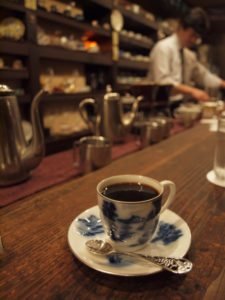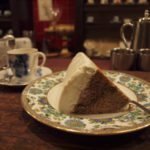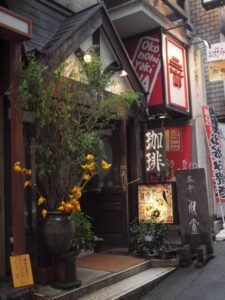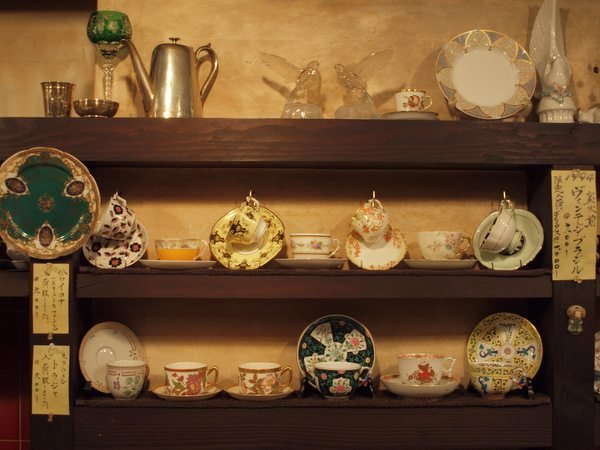Pour-Over Coffee in Tokyo: Chatei Hatou
 Coffee as Only the Japanese Could Do It
Coffee as Only the Japanese Could Do It
Though I had a screen shot of a map on my phone, I couldn’t find the very special Shibuya coffee shop I wanted to see. The sullen mist over Tokyo had turned to a steady more substantial rain and I rushed around the block as if trying to find a breach in the ramparts of a castle. Yet I could find no alley or walkway into the middle where the mighty Google Maps had marked the front door. I ducked into a the lobby of what appeared to be a cooking school with windowed test kitchen classrooms full of students with white aprons. From the front door I could see out the back window of the building to the center of the block.
The receptionist asked if she could help, and her eyes went wide when it was obvious our interaction was going to proceed without any Japanese other than Thank you, Sorry, and Excuse me. A polite foreign moron, how sweet. I gave her the transliterated name of the place – misspelled to make matters worse – and she looked it up on the internet, with two compatriots kibitzing over her shoulder, and offered to take me there. I protested in clownish charades that she would get wet, but she insisted and ran – seriously, as if my finding a coffee shop were a serious matter and time were critical – to a broom closet, emerging with two small see-through blue-tinted umbrellas.
We walked clear around to the other side of the block where I had started, passing a massive construction project – essentially a gaping hole of mud and concrete – and I worried that my coffee shop now only existed in a cache on the internet. Suddenly she pointed and blurted “Hatou!” and noting its similarity with what I had written on paper for her moments before – there was an ‘H’ in it – I knew it was right. Chatei Hatou.
She tried to leave me the umbrella but I insisted she take it back. How would I explain to her that I had one tucked into my backpack? I had been too stubborn to take it out as the mist had grown heavier and I was sure I was just steps from my goal? I thanked her repeatedly. With my Mr. Roboto Japanese. Polite moron. Domo. Domo.
And from the rivulets around my feet on the sloping asphalt, I stepped into warmth and serenity. The room was long before me with a low wooden counter along the right. Two customers looked up briefly, another was reading a book at a table near the room’s dogleg to the left in back. An exposed wood-beam ceiling hung low over my head, and a menagerie of art, porcelain figures, preserved plants, and other bric-à-brac rested along ledges and tables. Along the wall behind the counter spaced evenly along the shelves was a motley collection of porcelain saucers, tea cups, espresso glasses, and coffee cups.
I took a seat at the bar, and a woman making a sandwich behind the counter paused to offer me a menu in Japanese. We both looked at it uncertainly and she seemed to apologize as she withdrew it again. How to make this as simple as possible? I had read about Chatei Hatou online, about the types of coffee it offered, about the Japanese pour-over method that had started a minor fad with serious coffee geeks around the world, so I said, “Coffee.” “Hai,” she nodded and repeated, “Coffee.” “Old beans,” I said. Hai, old beans. “Hot.” She tilted her head to her left to try to shake a couple English words up to the top, “Eeeeeh, bitter? … or…” She drifted off, unsure of the English for the alternative. It didn’t matter to me, “Bitter. Hai,” I told her.
The barista, a man with his tie clipped to his shirt, took the order with a glance at me. He rinsed a stained cloth strainer on a wire loop with a handle and pressed the water out of it with a towel for a minute. He rested it on a wire stand and went to a metal canister for some “old beans.” The alternative to bitter is mild, I later discovered. The old beans are aged for three years before being roasted.
He put a cup full of beans through an antique coffee grinder with an Egyptian figure on it, and tapped the cup as the grounds slipped into the strainer until it was round and full. With a long round wooden spindle he worked his way around the edges to distribute the grounds evenly and then finished by making a small depression in the center. From beneath the counter he drew a large tea kettle and poured hot water into a much smaller tea pot with a long curving spout.
With the greatest patience and steady hands he tipped the pot, and nearly drop by drop soaked the surface of the grounds for several minutes. He rested the strainer on the stand as he prepared a glass coffee pot and set that below the strainer. But then he returned to soaking the grounds. This went on for more time than a Mr. Coffee would take to brew a whole pot, and I became fascinated by how much water dry coffee can absorb without letting one single drop pass through. After it was saturated, he returned the strainer to its position over the coffee pot, and again, with complete concentration, began pouring the hot water, a thin stream from the spout. A tiny mound of foam rose at the center of the grounds.
Classical music plays softly at Chatei Hatou, and while my cup was being brewed with reverence, a choir of monks sang Gregorian chant complete with the reverberation of a cathedral.
When it was complete, the barista turned to the back wall and spent moments considering his selection from the porcelain espresso glasses. He rinsed a saucer and then a cup with hot water, and placed them on the counter. He filled the shot, and set the silver coffee spoon alongside, pausing to turn the cup’s handle  just so with his fingertips before moving it toward me.
just so with his fingertips before moving it toward me.
Surprisingly the coffee still retained heat thanks in part to the hot soaking of the cup. I sipped at it and ordered a slice of the in-house chiffon cake – Earl Grey flavored – and disappeared into the most recent book on my reading list, a David Mitchell novel.
While it’s not quite the Japanese tea ceremony, it had its ceremonious appeal. Tedious or charming? If it’s 6 a.m. and just want to jump start your day, it’s bullshit. Likewise if you can’t discern the flavors of a Guatemalan organic dark roast from a cup of Folger’s diner coffee. But ducking in from the gray falling over Tokyo soaking into your coat, with a great book, some time to read, and a seat in the corner, it’s pretty damn cool.
_____________________
 Chatei Hatou Coffee Shop
Chatei Hatou Coffee Shop
Higasiguti Futaba Bldg. 1F, 1-15-19 Shibuya, Shibuya-ku, Tokyo
住所 東京都渋谷区渋谷1-15-19
Tel: 03-3400-9088
Nearest Station: Shibuya
Exit 13a from Shibuya station is an elevator to the sidewalk. Facing that elevator from the street, find the sidestreet to your right and go up that hill about 30 meters to find Chatei Hatou on the left looking like a little house.
Chatei Hatou also serves sandwiches, prepared with almost as much care as the coffee. Besides the pour-over variety, they also offer cafe au lait, cappuccino, and chocolate coffee, and a variety of teas, all of which can be iced.
If this sort of coffee ritual appeals to you, Amazon actually sells pour-over coffee paraphernalia.
Next Blog: The antithesis of this experience, food no ceremony could save!
Over on The Mad Traveler home page: Japan’s Iconic Clothing: The Kimono






 ORDER YOUR COPY TODAY!
ORDER YOUR COPY TODAY! ORDER YOUR COPY TODAY!
ORDER YOUR COPY TODAY!
Interesting piece. These guys need to play catch-up, though: One of my local coffee shops is offering pumpkin-pie latte (chocolate optional). Can the Japanese pour-over baristas match that? 🙂
Oh man, do we really want to go there? Seaweed-infused wasabi latte perhaps? I shudder to think.
Pingback: Turkish Coffee: Its Past and Your Future
Pingback: Terror From Above: The Air Mos Burger
Pingback: 2011 Reading in Review: Book Recommendations
Wow, I haven’t seen this place in all my visits to Tokyo.
The funny thing is “discovered” it via a coffee shop in Madison, Wisconsin. They are serving this sort of coffee and it is annoyingly expensive. I googled to see what the heck it was and stumbled upon a New York Times article about the trend. They mentioned the shop in Tokyo and voila, I had a mission.
I just tried it today. One of the better coffees that I have had in Tokyo. Think it’s going to be a regular stopping off point!
I tried it on the basis of your review and actually pretty good. Good coffee in Tokyo is hard to find and, although it may not all be entirely to my taste, this was different enough to have me going back in every once in a while.
Pingback: The Random Show: Hating Tech, Hidden Japanese Gems, Sexual Awkwardness, and More | The Blog of Author Tim Ferriss
Pingback: The Random Present: Hating Tech, Hidden Japanese Gems, Sexual Awkwardness, and Extra | Posts